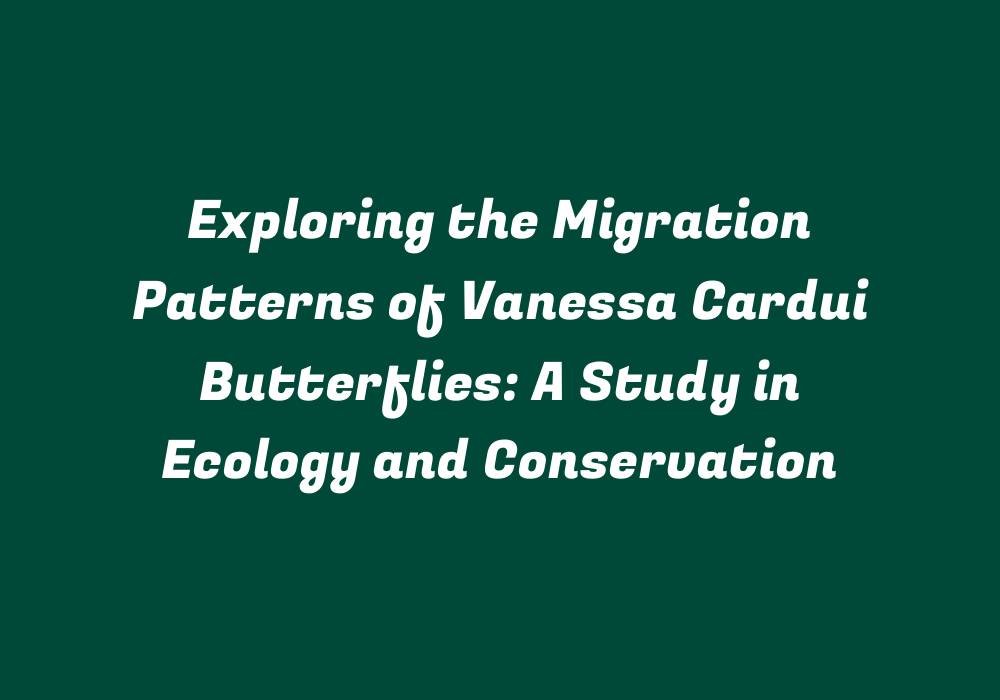Introduction to Vanessa Cardui Butterflies: A Study on Migration Patterns
Vanessa cardui, commonly known as the painted lady butterfly, belongs to the family Nymphalidae. It is a migratory species with distinctive patterns found across various regions of the world. These butterflies have captivated the interest of scientists and researchers alike for their unique behavior and adaptation abilities.
Understanding the Migration Patterns
The Vanessa cardui butterfly’s migration is characterized by periodic movements from its breeding ground to other regions in search of optimal environmental conditions. This adaptability enables them to survive and thrive despite seasonal changes, food scarcity, and predation pressures.
Factors Influencing Migration
Climate Change: Global warming has led to a rise in temperature, which may have significant impacts on the migration patterns of Vanessa cardui. Increased temperatures can affect habitat suitability and food availability, leading to changes in their migratory behaviors. Consequently, researchers must adapt their studies to incorporate these new environmental factors.
Population Dynamics: Migration plays a crucial role in maintaining the genetic diversity of Vanessa cardui populations across different regions. By dispersing individuals and bringing together distinct gene pools, migration can help ensure that the species remains resilient in the face of various environmental challenges.
Ecological Implications
Pollination: Vanessa cardui butterflies serve as important pollinators during their migrations, contributing to plant reproduction and ultimately supporting the continuity of various ecosystems. Their movements across diverse habitats facilitate cross-pollination among different plant species, ensuring a healthy balance between floral communities.
Food Resources: Migration also affects the availability of food resources for Vanessa cardui butterflies. As they move to new locations, their consumption habits may alter the dynamics between host plants and other insects that compete for limited food supplies. Consequently, understanding these changes can help researchers develop better management strategies for conservation efforts.
Conservation Efforts
Preserving Habitats: Maintaining and restoring habitats that support Vanessa cardui butterflies is crucial to the success of their migration. This can include promoting the growth of host plants, preserving vital foraging areas, and managing invasive species that compete with native vegetation.
Monitoring Population Movements: By tracking the movements of Vanessa cardui butterflies during migration periods, scientists can identify potential threats to their survival and develop effective conservation strategies. This approach could involve establishing monitoring networks across various regions where these insects are known to inhabit.
Conclusion
The study of Vanessa cardui butterflies’ migration patterns is a fascinating journey into the world of ecology and conservation. By understanding their adaptability, researchers can better appreciate the significance of these insects in maintaining diverse ecosystems across different regions. This knowledge also provides valuable insights for developing targeted strategies to preserve and protect both the species itself and its interdependent environment.
Resources
Assessing the impact of environmental factors on migration in Vanessa cardui (Lepidoptera) using a new bioecological model
Population dynamics and migration behavior of Vanessa cardui (Lepidoptera: Nymphalidae) in different habitats
Genetic diversity and migration patterns in Vanessa cardui (Lepidoptera, Nymphalidae) across the European-Mediterranean region: A first study using microsatellites
Interactions between Vanessa cardui (Lepidoptera: Nymphalidae) and its host plant Ricinus communis (Euphorbiaceae) in relation to the urbanization
These studies, along with others on various aspects of Vanessa cardui’s ecology and behavior, can help us further our understanding of these fascinating insects and their crucial role in maintaining healthy ecosystems.
